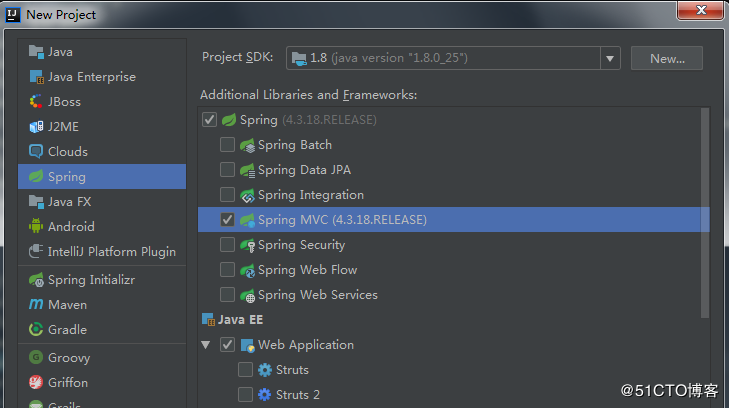Java Tomcat SpringMVC 页面访问 Java +Tomcat + SpringMVC实现页面访问示例解析
shayang88 人气:0window7下Java环境安装记录:
一、安装Tomcat
1、下载tomcat 7.0,解压,无需安装,放置到目录:D:\apache-tomcat-7.0.90。
2、配置系统环境变量,CATALINA_BASE=D:\apache-tomcat-7.0.90,CATALINA_HOME=D:\apache-tomcat-7.0.90,在Path中新增“%CATALINA_HOME%\lib;%CATALINA_HOME%\bin”的环境变量。
3、进入D:\apache-tomcat-7.0.90\bin,执行startup启动tomcat,浏览器中输入“127.0.0.1:8080”即可查看是否成功。
二、使用SpringMVC搭建页面
1、使用Idea创建SpringMVC工程,webAppTest2

2、修改web/WEB-INF/web.xml的url规则为接受所有
<?xml version="1.0" encoding="UTF-8"?>
<web-app xmlns="http://xmlns.jcp.org/xml/ns/javaee"
xmlns:xsi="http://www.w3.org/2001/XMLSchema-instance"
xsi:schemaLocation="http://xmlns.jcp.org/xml/ns/javaee http://xmlns.jcp.org/xml/ns/javaee/web-app_4_0.xsd"
version="4.0">
<context-param>
<param-name>contextConfigLocation</param-name>
<param-value>/WEB-INF/applicationContext.xml</param-value>
</context-param>
<listener>
<listener-class>org.springframework.web.context.ContextLoaderListener</listener-class>
</listener>
<servlet>
<servlet-name>dispatcher</servlet-name>
<servlet-class>org.springframework.web.servlet.DispatcherServlet</servlet-class>
<init-param>
<param-name>contextConfigLocation</param-name>
<param-value>classpath:dispatcher-servlet.xml</param-value>
</init-param>
</servlet>
<servlet-mapping>
<servlet-name>dispatcher</servlet-name>
<url-pattern>/</url-pattern>
</servlet-mapping>
</web-app>
3、在src下创建dispatcher-servlet.xml文件
<?xml version="1.0" encoding="UTF-8"?>
<beans xmlns="http://www.springframework.org/schema/beans"
xmlns:xsi="http://www.w3.org/2001/XMLSchema-instance"
xmlns:context="http://www.springframework.org/schema/context"
xmlns:mvc="http://www.springframework.org/schema/mvc"
xsi:schemaLocation="http://www.springframework.org/schema/beans http://www.springframework.org/schema/beans/spring-beans.xsd
http://www.springframework.org/schema/context http://www.springframework.org/schema/context/spring-context-4.1.xsd
http://www.springframework.org/schema/mvc http://www.springframework.org/schema/mvc/spring-mvc-4.1.xsd">
<!-- scan the package and the sub package -->
<context:component-scan base-package="test"/>
<!-- don't handle the static resource -->
<mvc:default-servlet-handler />
<!-- if you use annotation you must configure following setting -->
<mvc:annotation-driven />
<!-- configure the InternalResourceViewResolver -->
<bean class="org.springframework.web.servlet.view.InternalResourceViewResolver"
id="internalResourceViewResolver">
<!-- 前缀 -->
<property name="prefix" value="/WEB-INF/jsp/" />
<!-- 后缀 -->
<property name="suffix" value=".jsp" />
</bean>
</beans>
4、在src下创建test目录,目录下同时创建MyController文件
package test;
import org.springframework.stereotype.Controller;
import org.springframework.web.bind.annotation.RequestMapping;
@Controller
@RequestMapping("/mvc")
public class MyController {
@RequestMapping("/hello")
public String hello(){
return "hello";
}
}
5、在web/WEB-INF下创建classes和lib文件夹,用来设置编译的.class文件目录和第三方依赖包目录。

6、web/WEB-INF/下创建jsp目录,并在目录下创建hello.jsp
<%@ page contentType="text/html;charset=UTF-8" language="java" %> <html> <head> <title>Title</title> </head> <body> Hello world!!!! </body> </html>
7、打war包Build-->Build Artifacts,包名webAppTest2,放到D:\apache-tomcat-7.0.90\webapps目录下。
8、重启tomcat,访问http://127.0.0.1:8080/webAppTest2/mvc/hello 即可。

9、也可以设置Idea内置Tomcat,直接Idea内启动浏览器


10、省略工程名,直接访问即可

加载全部内容